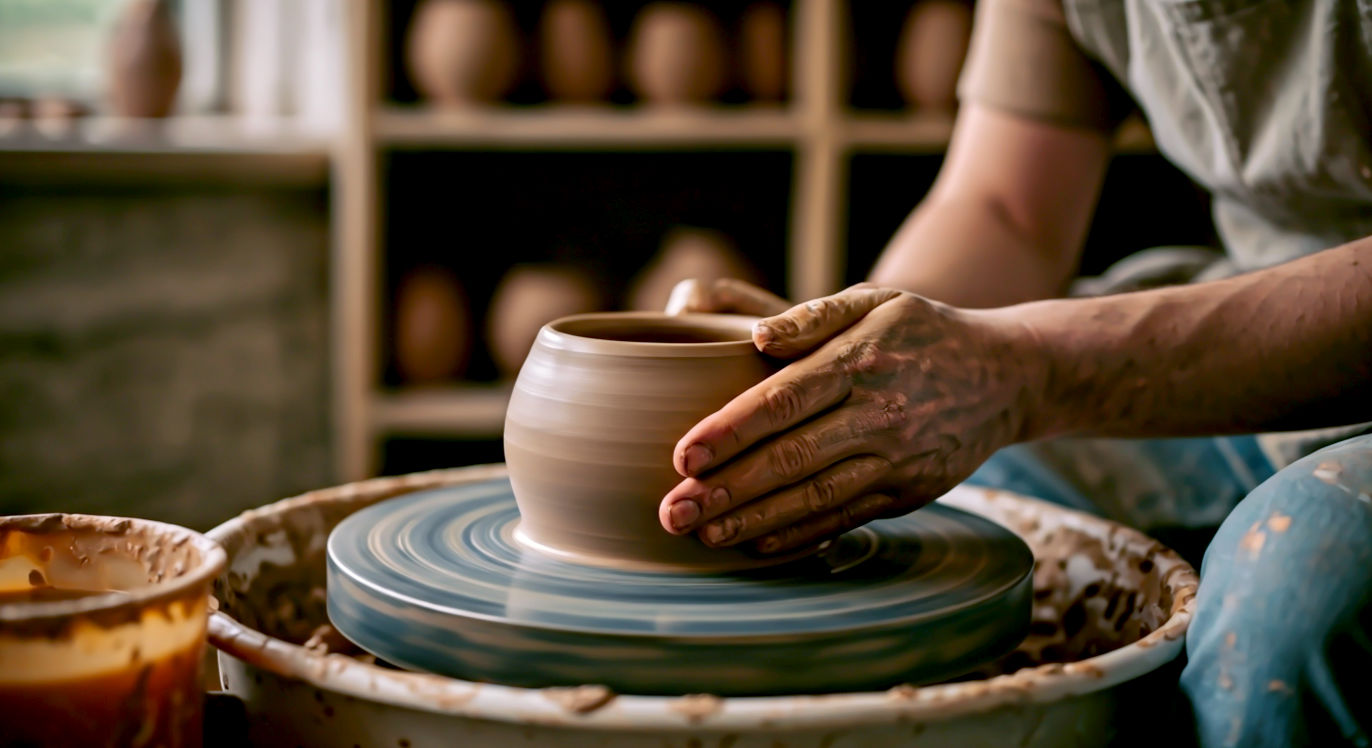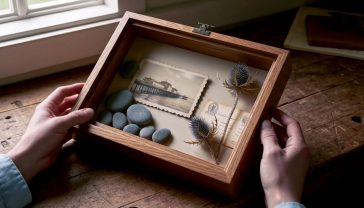The Great British Debate: Where Craft Ends and Art Begins
We dive into the story of British handcraft to untangle the age-old debate: what’s the difference between art and craft? And why does it matter more than ever?

This post may contain affiliate links. If you make a purchase through these links, we may earn a commission at no additional cost to you.
Picture this. You’re wandering through a weekend market, maybe in a buzzy corner of Bristol or a quaint village hall in the Cotswolds. You pass stalls piled high with artisan bread and local cheeses. Then, you see it: a beautifully crafted ceramic mug. It’s not like the ones in the supermarket. The glaze has a deep, rich colour, you can see the faint trace of the maker’s fingers, and it sits in your hand just right. It’s a tenner. You buy it, and every morning your tea tastes just a little bit better for it.
Now, picture this. You’re in a sleek, white-walled gallery in London, like the Tate Modern. In the middle of a room, on a stark white plinth, sits a single, oddly-shaped ceramic object. It’s twisted and bumpy, the glaze is cracked, and you definitely couldn’t drink your tea out of it. There’s a little card next to it with a long, confusing title. It’s worth thousands of pounds. It’s Art.
But wait. Aren’t they both just… lumps of clay? Why is one a humble mug and the other a priceless masterpiece? This is one of the oldest, most tangled, and most interesting debates in the creative world: the difference between art and craft.
For centuries, we’ve been told there’s a clear line. Fine art—painting, sculpture, the stuff you see in grand galleries—is supposedly about ideas, emotions, and pure expression. It doesn’t have a job to do other than to make you think or feel something. Handcraft, on the other hand, is about skill, function, and tradition. It’s the pot you use, the chair you sit on, the scarf that keeps you warm.
But that line has become wonderfully, gloriously blurry. In fact, many of the most exciting creators in Britain today are stomping all over it. They’re potters whose work is shown in international art fairs and weavers whose creations are considered powerful political statements. They are proving that an object can be both beautiful and useful, skilful and soulful.
This article is your guide to this fascinating world. We’ll untangle the history of how art and craft got separated, celebrate the British heroes who fought to bring them back together, and explore the incredible skills that turn clay, wood, and wool into objects of wonder. It’s a journey that will change the way you see that ten-pound mug forever. Because that mug isn’t just a thing to hold your tea; it’s a story, a skill, and a quiet rebellion against a world of mass-produced stuff. It’s a different, and perhaps more human, definition of art.
What’s the Big Idea? Unpacking Art vs. Craft
Before we dive into the history, let’s get our terms straight. It’s a bit like trying to explain the rules of cricket—it seems complicated at first, but the basic idea is quite simple.
The Fine Art Corner
Traditionally, ‘fine art’ was seen as the top dog. Think of Leonardo da Vinci’s Mona Lisa or Turner’s dramatic seascapes. The whole point of these works is to be looked at and admired. They’re driven by an artist’s unique vision or a powerful idea.
- Primary Purpose: Expression, ideas, beauty, and challenging perceptions.
- The Medium: Often painting, sculpture, or drawing.
- The Value: Lies in its originality and the concept behind it. It’s a one-off.
- The Question it Asks: “What does this make me feel or think?”
Fine art is the lead singer of the band—flamboyant, a bit self-important, and there to deliver a message.
The Handcraft Camp
Handcraft, or ‘applied art’, was historically seen as the supporting act. It’s the creation of objects that are meant to be used. The word ‘craft’ itself comes from the Old English cræft, meaning strength or skill. It’s all about the mastery of a material and a technique.
- Primary Purpose: Function. A pot is for holding water, a chair is for sitting.
- The Medium: Often ceramics, textiles, wood, glass, or metal.
- The Value: Lies in the quality of the workmanship, the material, and its fitness for purpose.
- The Question it Asks: “How well is this made and does it work?”
Handcraft is the band’s brilliant drummer—less flashy, but providing the essential, skilful rhythm that holds everything together.
Where It All Gets Blurry
For a long time, this division was like a strict class system. The artist was a lone genius, while the craftsperson was a skilled worker. But this way of thinking is full of holes.
Think about a medieval illuminated manuscript. It’s a book (functional), but the illustrations are breathtakingly beautiful and expressive (art). What about a stained-glass window in a cathedral? It’s a window (functional), but it also tells a profound religious story (art).
The truth is, the separation between art and craft is a relatively new idea. For most of human history, the most beautiful objects were also the most useful. The real split happened for a very British reason: the Industrial Revolution.
A Very British Break-Up: How Industry Divorced Art from Craft
In the 18th and 19th centuries, Britain changed forever. Factories and machines began churning out goods faster and cheaper than ever before. Suddenly, you didn’t need a skilled weaver to make your cloth or a potter to make your plates. A machine could do it.
This had a massive impact on craftsmanship. On the one hand, it made things affordable for ordinary people. On the other hand, the quality often nosedived. Factory-made furniture fell apart, textiles were garish, and the objects lost their soul. They were made by machines, not by hands; designed by a committee, not by a single person who understood the material. The link between the maker and the object was broken.
At the same time, the idea of the ‘artist’ as a special, romantic genius was taking hold. Artists were seen as being above the grubby world of commerce and industry. They created ‘art for art’s sake’. And so, the two paths diverged. Art went into the gallery, and craft stayed in the workshop, or worse, was replaced by the factory.
But a group of radical British thinkers, artists, and designers looked at this new world and were horrified. They decided to fight back.
The Heroes of Handcraft: The Arts and Crafts Movement
The fightback was called the Arts and Crafts Movement, and it’s one of Britain’s most important contributions to global design. Its spiritual leader was the writer and art critic John Ruskin, but its most famous champion was the brilliant, bearded, and endlessly energetic William Morris.
Morris was a true visionary. He looked at the ugly, poorly made stuff pouring out of the factories and believed it was making society worse. He argued that the work we do and the objects we surround ourselves with should be meaningful and beautiful. His famous motto was: “Have nothing in your houses that you do not know to be useful, or believe to be beautiful.”
In 1861, Morris and his friends founded a company, Morris, Marshall, Faulkner & Co., to create beautifully designed, handcrafted furniture, wallpaper, textiles, and stained glass. They rejected the machine and championed the hand. They believed in:
- Honesty of Materials: Using wood that looked like wood and celebrating its natural grain, not covering it with fake finishes.
- Skilled Workmanship: Valuing the knowledge and skill of the individual craftsperson.
- Joy in Labour: Morris believed that factory work was dehumanising. He argued that craftspeople who designed and made an object from start to finish took pride and joy in their work.
- Beauty in Everyday Life: He wanted to break down the barrier between fine art and decorative art. A beautiful wallpaper pattern, he argued, was as valid a form of artistic expression as a painting.
The Arts and Crafts Movement was hugely influential. It spread across Europe and America and laid the groundwork for modern design. It reminded people that the things we use every day matter. It made ‘handmade’ a badge of honour again. And most importantly, it stated loud and clear that craft is art.
The Class of Craft: A Tour of Britain’s Great Traditions
The Arts and Crafts Movement revived an interest in traditional skills that had been passed down for generations. Britain has a rich history in many craft disciplines, each with its own materials, techniques, and stories. Let’s take a tour of the workshop.
Ceramics: From Roman Pots to The Great Pottery Throw Down
Clay is one of humanity’s oldest materials. In Britain, people have been making pottery for over 6,000 years. The Romans established huge pottery industries, and towns like Stoke-on-Trent became world-famous as ‘The Potteries’, home to brands like Wedgwood and Spode.
But while the big factories industrialised pottery, a different tradition was bubbling under the surface: studio pottery.
In the early 20th century, pioneers like Bernard Leach and the Japanese potter Shoji Hamada set up a pottery in St Ives, Cornwall. They rejected the perfection of factory ceramics and were inspired by the simple, rustic pottery of Japan, Korea, and medieval England. They believed a pot should show the hand of its maker. For them, a fingerprint left in the clay or a slight wobble in the rim wasn’t a mistake; it was a sign of life.
Leach’s ideas inspired generations of British studio potters. Figures like Lucie Rie, an Austrian émigré who became a Dame, and Hans Coper, created stunning, sculptural vessels that were closer to sculpture than functional tableware.
Today, British studio ceramics is more vibrant than ever. TV shows like The Great Pottery Throw Down have brought the magic of the potter’s wheel into millions of living rooms. Potters like Grayson Perry use traditional vase forms to explore complex ideas about society, identity, and politics, winning the prestigious Turner Prize for art in the process. His work perfectly illustrates the blurred line: it’s undeniably craft in its technique, but it’s also undeniably capital-A Art in its intent.
The Potter’s Toolkit:
- Earthenware: Fired at a low temperature, it’s porous and often used for terracotta pots.
- Stoneware: Fired at a high temperature until it’s hard and stone-like. It’s tough and waterproof, perfect for mugs and plates.
- Porcelain: The poshest of the clays. It’s fired at very high temperatures, making it translucent, white, and delicate, but also incredibly strong.
Textiles: More Than Just Knitting
Britain’s story is woven with wool. The medieval wool trade made England rich, and the textile mills of the north powered the Industrial Revolution. But alongside the industrial looms, the hand-making of textiles has always continued.
Textile art covers a huge range of techniques:
- Weaving: Interlacing threads on a loom to create fabric. Think of the iconic, tough Harris Tweed, which by law must be hand-woven by islanders in their homes in the Outer Hebrides of Scotland. It’s a craft that is deeply connected to a place and its people.
- Knitting and Crochet: Creating fabric from a single strand of yarn using needles or a hook. Once seen as a purely domestic ‘women’s work’, it’s now a major artistic medium.
- Embroidery: Decorating fabric with needle and thread. The famous Bayeux Tapestry (which is actually an embroidery) tells the story of the Norman conquest. In modern times, artists use embroidery to create intricate pictures or powerful political statements in a movement known as ‘craftivism’.
- Quilting: Stitching together layers of fabric. Historically a way to use up scraps and make warm bedcovers, it has evolved into a sophisticated art form with complex patterns and designs.
Today, textile artists are pushing the boundaries of what fabric can do, creating huge, sculptural installations and detailed, narrative tapestries that hang in galleries and museums.
Wood: The Heart of the Matter
Britain was once covered in ancient forests, and wood has always been a fundamental material for shelter, tools, and furniture. The tradition of green woodworking—using freshly felled, unseasoned wood—is ancient. Bodgers, who were often itinerant craftsmen, would set up their simple pole-lathes in the woods to turn chair legs from beech trees.
The Arts and Crafts Movement sparked a new appreciation for the beauty of native British woods like oak, ash, and elm. Designers like Ernest Gimson and Sidney Barnsley moved to the Cotswolds to make exquisite furniture that celebrated the skill of the cabinet maker and the natural qualities of the wood.
Today, woodworking is thriving. From the functional beauty of a hand-carved spoon to the sleek elegance of a bespoke piece of furniture, makers are exploring both traditional skills and modern design. It’s a craft that connects us directly to our landscape and the slow, steady life of trees.
And the Rest… Glass, Metal, and More
The list of British crafts is long and deep.
- Glassblowing, a skill brought here by the Romans, can be seen in everything from medieval church windows to the dazzling contemporary sculptures created by artists in centres like the National Glass Centre in Sunderland.
- Blacksmithing, the art of heating and hammering metal, is no longer just about making horseshoes. Artist-blacksmiths forge incredible architectural ironwork and delicate sculptures.
- Silversmithing and Jewellery have moved far beyond traditional styles, with makers using precious metals, but also plastics, paper, and found objects to create wearable art.
- Basketry, using willow and other natural fibres, is one of our oldest crafts, connecting us back to a time when we made everything we needed from the land around us.
The Modern Maker: Craft in the 21st Century
So, where does handcraft stand today? In our world of smartphones, fast fashion, and one-click ordering, you might think it would be a dying art. But the opposite is happening. We are in the middle of a massive craft revival.
Why? It seems that in an increasingly digital and disposable world, we are craving things that are real, authentic, and human.
The Rise of the Maker Movement
The internet, which could have been the final nail in craft’s coffin, has instead become its greatest champion. Websites like Etsy and Not on the High Street allow individual makers to sell their work directly to customers all over the world. Social media platforms like Instagram have become virtual galleries, where craftspeople can share their process, tell their story, and build a community around their work.
This has fuelled the ‘maker movement’, a global trend for appreciating and participating in small-scale, independent making. People don’t just want to buy handmade; they want to make it themselves. Evening classes in pottery, weaving, and spoon-carving are booming.
The Value of the Imperfect
For centuries, the goal of the craftsperson was perfection. But today, we often value the opposite. In Japanese aesthetics, there is a concept called wabi-sabi, which is about finding beauty in imperfection and impermanence. A wonky cup or a piece of wood with a knot in it has character. It has a story. It tells you that it was made by a human being, not a soulless machine. This search for authenticity is a powerful driver behind the new craft movement.
Craft and Wellbeing
There’s another, deeper reason for craft’s resurgence: it’s good for us. In a world that often feels frantic and overwhelming, the slow, repetitive, and focused nature of craft can be a powerful antidote. The idea of ‘mindful making’ has become popular.
When you’re concentrating on the rhythm of knitting or the feel of clay spinning in your hands, your mind doesn’t have space to worry about emails or deadlines. It’s a form of meditation. Making something tangible and beautiful with your own hands provides a huge sense of satisfaction and achievement that is often missing from modern jobs. It connects our hands to our heads, and many people find it essential for their mental health.
How to Be a Craft Champion: A Practical Guide
Convinced? Want to dive deeper into the world of handcraft? Here’s how you can see it, buy it, and even try it for yourself in the UK.
Where to See Great Craft
Forget the idea that craft only belongs in dusty folk museums. The UK’s best galleries and museums now celebrate it as a major art form.
- The Victoria and Albert Museum (V&A) in London: The V&A is the world’s leading museum of art, design, and performance, and it has an incredible collection of ceramics, textiles, furniture, and more, from all over the world and throughout history.
- The Crafts Council Gallery, London: The national organisation for craft, their gallery showcases the most exciting and innovative contemporary craft.
- Regional Centres of Excellence: Many parts of the UK are hubs for specific crafts. Visit St Ives in Cornwall for pottery, the Devon Guild of Craftsmen for a wide range, or The Harley Gallery on the Welbeck Estate in Nottinghamshire.
Where to Buy Great Craft
When you buy directly from a maker, you’re not just getting a unique object; you’re supporting a small business, preserving a skill, and investing in a real person’s creativity.
- Craft Fairs: These are fantastic places to meet makers and see a huge variety of work under one roof. Look out for big national events like Collect (high-end international art fair for craft), Great Northern Contemporary Craft Fair in Manchester, and smaller local events.
- Open Studios: Many craftspeople open their workshops to the public once or twice a year. It’s a wonderful chance to see where the magic happens and chat with the maker.
- Online: As well as the big sites like Etsy, many makers have their own online shops. The Crafts Council also has a directory of makers on its website.
What to Look For When Buying
- Skill: Look closely at the quality of the making. Are the joints neat? Is the finish good? It should feel like it was made with care and expertise.
- Material: Does the maker celebrate the material? A good woodworker will use the grain to enhance the design. A good potter will choose a glaze that complements the form.
- Story: Ask the maker about the piece. What inspired it? How was it made? A handmade object with a story is infinitely more special.
How to Get Started Yourself
The best way to appreciate a skill is to try it.
- Local Courses: Check your local college, arts centre, or even independent workshops for taster sessions or beginner’s courses.
- Craft Kits: Many makers now sell kits online, so you can try a new skill from the comfort of your own home.
- Online Tutorials: YouTube is a treasure trove of ‘how-to’ videos for almost any craft imaginable.
The Future is Handmade
So, what is the final verdict in the case of Art vs. Craft? The truth is, there is no verdict, because the division itself is flawed.
It’s not a question of Art or Craft. It’s a spectrum. At one end, you have pure function (a well-made, but basic, hammer). At the other, you have pure expression (a painting that has no function other than to be itself). The vast, rich, and exciting territory in between is where art and craft meet, mingle, and create beautiful things together.
A great piece of handcraft has it all. It has the skill and deep knowledge of material that defines craft. But it also has the vision, intent, and soul that defines art.
The legacy of William Morris and the Arts and Crafts movement is more relevant now than ever. In our fight against climate change and throwaway culture, the craft ethos of making things that are beautiful, durable, and meaningful offers a more sustainable way to live. A well-made wooden chair can last for generations, becoming more beautiful with age. It is the ultimate enemy of landfill.
The next time you pick up a handmade object, take a moment. Feel its weight, notice its texture, and appreciate the hours of focused work that went into it. Think of the centuries of tradition and knowledge that are held within that maker’s hands. You’re not just holding a thing. You’re holding a story. And that is a powerful kind of art.
Further Reading & Resources
To continue your journey into the world of art handcraft, these respected British organisations are the best places to start:
- The Crafts Council: The national charity for craft. An excellent resource for finding makers, exhibitions, and learning opportunities across the UK.
- The Victoria and Albert Museum (V&A): Explore thousands of years of craft and design from Britain and around the world through their incredible online collection.
- The Heritage Crafts Association: A charity dedicated to supporting and preserving traditional craft skills. Check out their ‘Red List of Endangered Crafts’ to see which skills are at risk of disappearing.






